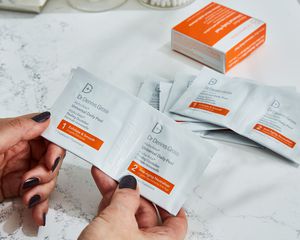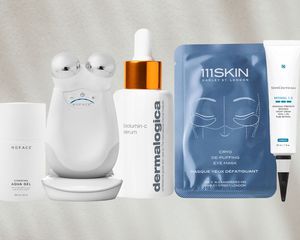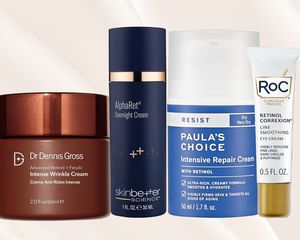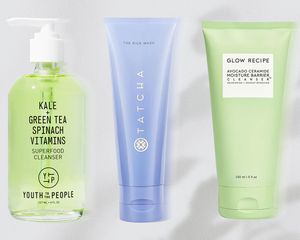:max_bytes(150000):strip_icc()/GettyImages-7359326251-19f044e6230d498e99a2a66aa5a075d0.jpg)
Westend61/Getty
Of the many skin concerns people have, acne seems to be top of mind. We're talking cysts, whiteheads, and blackheads—primarily. Each have a type of umbrella treatment that works to keep them at bay, but if they don't go away after a while, it could be that you're confusing the type of breakout for something entirely different. In this case, we're talking about blackheads and sebaceous filaments, which are both results of sebum (oil) buildup in the pores and are often found on the nose. While the two often look similar in appearance, they're entirely different and must therefore be approached differently. What's more, sebaceous filaments aren't even a type of breakout.
Now that we know that sebaceous filaments aren't actually blackheads, but rather something entirely different, we tapped four skin care experts to break down what exactly they are and how to reduce their appearance. Their insights, below.
Meet the Expert
- Brendan Camp, MD, is a double board-certified dermatologist at MDCS Dermatology in New York City.
- Renée Rouleau is a celebrity esthetician and the founder of Renée Rouleau Skin Care.
- Kat Burki is a skincare expert and founder of her eponymous brand.
What Are sebaceous filaments?
“Sebaceous filaments are naturally occurring, tube-like structures that line the walls of your pores," explains celebrity esthetician Renée Rouleau. "Their purpose is to direct oil flow.” Everyone has sebaceous filaments, they just become more visible when they are filled with oil.
When pores fill up with oil, the sebaceous filaments that line the pores to facilitate oil to the skin become more visible, resulting in the little yellow and gray dots you notice along your nose and cheeks. “Your skin produces oil (also known as sebum) to protect and moisturize itself. Sebaceous filaments help guide that oil from your sebaceous glands, where the oil is produced, to the surface of your skin, where the oil can get to work fighting environmental aggressors and dehydration,” Rouleau says. Since they're part of your skin, you can't get rid of them. However, you can minimize their appearance.
So, how exactly do we do that? Rouleau says that the answer is more complicated than we might hope. “Even if you extract or squeeze sebaceous filaments, they will fill up again within 30 days.” However, all hope isn't lost. Through a combination of products and treatments, you can lessen their appearance and help prevent them over time. “The most economical way to address sebaceous filaments is to make treating them part of a routine,” Dr. Camp reminds us.
Sebaceous Filaments vs Blackheads
Sebaceous filaments often appear very similar to blackheads, but they're different. A blackhead is a form of breakout as a result of clogged pores, while sebaceous filaments are actually a part of the anatomy of your pores that become more visible when they are filled with oil. “Blackheads are darker and tend to have a texture to them," explains Brendan Camp, MD, a double-board certified dermatologist in New York City. "Sebaceous filaments are a normal skin finding; they feel smooth, do not block pores, and everyone has them.”
How to Treat Sebaceous Filament:
Avoid Alcohol-Heavy Skincare
While a little bit of alcohol in a skincare product probably won't cause a reaction, Burki says that higher doses could have a negative impact. "Not only will the skin not breathe, which exacerbates sebaceous filaments, but if there are healthy ingredients in the product, your skin won't be able to absorb them," she furthers.
Balance Active Ingredients with Gentle Ones
For a sebaceous filaments-friendly routine, you'll need to balance harsher active ingredients with calming ones to keep your skin as healthy as possible.
"It’s imperative to tap into the healthy life cycle of skin with a regular exfoliation of alpha-hydroxy acids (AHAs), enzymes, and/or gentle physical exfoliates such as fibers at least two times a week. Next make sure after exfoliation the skin is flooded with ingredients that heal the new cell growth with antioxidants, vitamins, neuropeptides, ferments including algae, mushroom, and sea kelp. These ingredients deeply nourish and allow new cells to flourish," says Burki.
Keep Your Skin Clean
To prevent your pores from getting clogged and to keep them clear of debris, make sure to remove your makeup and cleanse your skin every day. If you have very oily skin, consider cleansing both in the morning and at night.
Use Chemical Exfoliants to Break Up Oil Plugs
“AHAs, such as glycolic and lactic acid, exfoliate the skin by removing dead skin cells,” explains Dr. Camp. “Beta-hydroxy acids (BHAs), like salicylic acid, are lipophilic, allowing them to mingle with oil deep within the pore and break up oil plugs.” This combination is a sebaceous filament-killer.
We recommend Herbivore's Botanicals' Prism Glow Serum, which packs 20 percent AHAs and 5 percent BHAs. To use, apply a thin layer once or twice a week and follow up with a gentle moisturizer.
Key Ingredients
Alpha-hydroxy acids are a group of acid compounds, most often derived from plant-based sources, which work to exfoliate the skin. They come in a variety of types (like glycolic and lactic acids) and differ in size, penetration, and potency.
Incorporate a Purifying Mask Into Your Routine
Face masks are great treatments for when your skin needs a little extra TLC. If you're intentional about choosing and using these masks, you can really see a huge impact over time on the sebaceous filaments in your skin.
"Clarifying masks can be incredibly helpful to not only add needed nutrients that have been stripped from the skin from astringent topicals, but they can encourage new healthier cell growth," explains Burki, who recommends her Dual Exfoliating Clay Mask.
For the best results, Burki says to supply the skin with healthy hydration after a mask — so make sure to moisturize your skin.
Keep Pores Clean With an Exfoliating Toner
BHAs like salicylic acid, work to clear pores of excess oil, dead skin cells, and debris. “It's able to cut through oil and get deep into your pores which will allow it to start breaking up the gunk clogging your pores, minimizing the appearance of the filaments and preventing more from cropping up,” explains Rouleau. If you have a pretty basic routine, this is going to pack a punch.
Regulate Oil Flow With Retinol
“Rouleau says that incorporating a retinol and/or retinoid into your skincare rotation can also be effective against sebaceous filaments as they increase skin cell turnover, which helps keep oil production in check.
“If your skin is sensitive or you haven't used retinol before, I suggest starting with an over-the-counter retinol,” Rouleau advises. “If you have oilier skin or have used retinol before, you can try a retinoid such as Differin, which is still available over the counter.” To use it, apply a thin layer of the gel daily after cleansing, though if you're sensitive or new to retinol, you should start by applying it two times per week and then work your way up to daily use.
Retinol and retinoids put in work, so you should see a difference in your skin within two months.
Take Supplements to Encourage New Cell Growth
Beauty comes from the inside out, so consider getting to the root of your concerns by taking a supplement. "Supplements—and food sources—high in vitamin B and antioxidants encourage new cell growth and healthy hydration. Look for vitamin B, C, A, enzymes, mushrooms and minerals," recommends Burki.
We really like ZitSticka's Skin Discipline, a supplement that promises to help promote healthier skin overall thanks to its combo of probiotics and fatty acids that helps regulate sebum and prevent inflammation. Just take one capsule a day, and enjoy the minty flavor.
Carefully Use an At-Home Extraction Tool to Unclog Pores
The Dermaflash Dermapore works by offering two modes, one for extraction and one for infusion. In extraction mode, the tool uses ultrasonic waves to vibrate away dirt and oil from clogged pores. It's important to keep your face damp throughout the treatment so that the tool smoothly glides over your skin, so we suggest steaming your face beforehand.
If you use it about once a week, you should see a noticeable improvement within a month of use as it vibrates away excess oil and dead skin cells.





